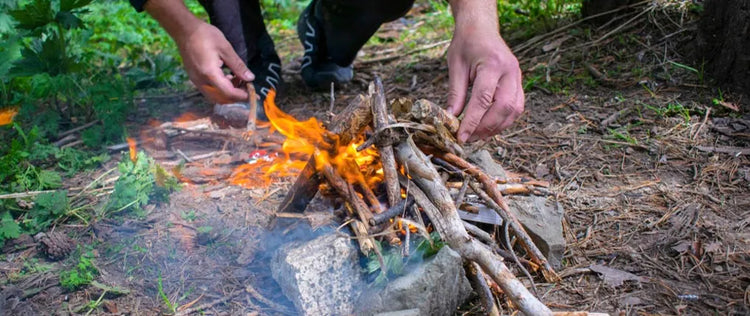Starting a campfire is a skill that many outdoor enthusiasts consider fundamental. Whether you’re camping, backpacking, or simply enjoying a night under the stars in your backyard, a campfire can provide warmth, light, and a means to cook food. In this comprehensive guide, we’ll walk you through the step-by-step process of starting a campfire safely and effectively.
Table of Contents:
- Safety First: Essential Campfire Precautions
- Materials You'll Need
- Selecting the Perfect Campfire Site
- Preparing the Fire Pit
- Building Your Fire: Different Methods
- Lighting the Fire
- Maintaining and Enjoying the Fire
- Extinguishing the Fire Properly
- Leave No Trace: Campfire Cleanup
- Pro Tips and Troubleshooting
1. Safety First: Essential Campfire Precautions
- Check Regulations: Before starting a fire, always check local fire restrictions and regulations. Some areas may prohibit fires during dry conditions.
- Keep Water and a Shovel Nearby: In case the fire gets out of control, you need tools to quickly suppress it.
- Never Leave a Fire Unattended: An unattended fire can quickly become a hazard. Always ensure someone is watching it.
2. Materials You'll Need:
- Tinder: Materials that catch fire quickly. Examples include dry leaves, grass, and pine needles.
- Kindling: Small sticks and twigs that burn hotter and longer than tinder.
- Firewood: Large pieces of wood that will form the bulk of your fire.
- Matches or a Lighter: Waterproof matches or a reliable lighter are essential.
- Firestarter: Optional, but useful in wet conditions. Examples include commercial firestarters, cotton balls soaked in petroleum jelly, or dryer lint.
3. Selecting the Perfect Campfire Site:
- Away from Flammable Materials: Ensure your site is away from trees, bushes, and other flammable materials.
- Wind Direction: If possible, position your fire site in a location that's shielded from the wind.
- Ground Surface: Choose a flat, stable ground surface.
4. Preparing the Fire Pit:
- Dig a Pit: Create a shallow pit in the ground about 2 feet across. This will protect your fire from wind and prevent it from spreading.
- Circle with Rocks: Encircle your pit with rocks. This will contain the fire and provide a heat barrier.
5. Building Your Fire: Different Methods
- Teepee Method: Start with a small teepee of tinder, then build a larger teepee of kindling around it. As the fire grows, add larger sticks and logs.
- Log Cabin Method: Lay two larger pieces of firewood parallel to each other. Place two smaller pieces on top, perpendicular to the first two. Continue alternating layers. Place tinder in the center.
- Lean-to Method: Drive a long piece of kindling into the ground at an angle. Lean smaller pieces of kindling against it. Place tinder underneath.
6. Lighting the Fire:
- Light the Tinder: Using matches or a lighter, ignite the tinder. As it burns, the kindling will catch fire, followed by the firewood.
- Add More Kindling: As the tinder burns, gradually add more kindling to grow the fire.
7. Maintaining and Enjoying the Fire:
- Add Firewood Gradually: Don't rush by adding too much wood. Let each piece catch fire before adding more.
- Reposition Logs: As the fire burns, move logs around to ensure even burning.
- Enjoy Responsibly: Remember, a campfire is not just for warmth and cooking. It's a place for stories, songs, and memories. Always respect its power.
8. Extinguishing the Fire Properly:
- Douse with Water: Pour water over the fire, ensuring all embers and logs are wet.
- Stir with a Shovel: Mix the ashes and embers to ensure everything is wet and no burning embers remain.
- Touch Test: Once you believe the fire is out, place the back of your hand near the ashes. If you feel heat, it's not fully extinguished.
9. Leave No Trace: Campfire Cleanup:
- Restore the Site: Once the fire is completely out and cold, scatter the ashes, replace any soil you removed, and return the site to its original state.
- Pack Out Trash: If you burned any trash (not recommended), ensure it's completely burned or pack it out with you.
10. Pro Tips and Troubleshooting:
- Wet Conditions: If everything's damp, use firestarters or look for dry wood under thick trees or logs.
- Hard-to-Start Fire: Ensure your materials are dry and that you're using enough tinder.
- Smoky Fire: This could be due to wet wood or poor ventilation. Adjust the logs to allow better airflow.
In Conclusion:
Starting a campfire is both an art and a science. With practice, you'll quickly become proficient and confident in your fire-making skills. Always prioritize safety and respect for the environment, and remember that the memories made around a campfire are often the ones that last a lifetime. Happy camping!
Explore Our Comprehensive Guide on the Top 25 things to bring while camping with your girlfriend


